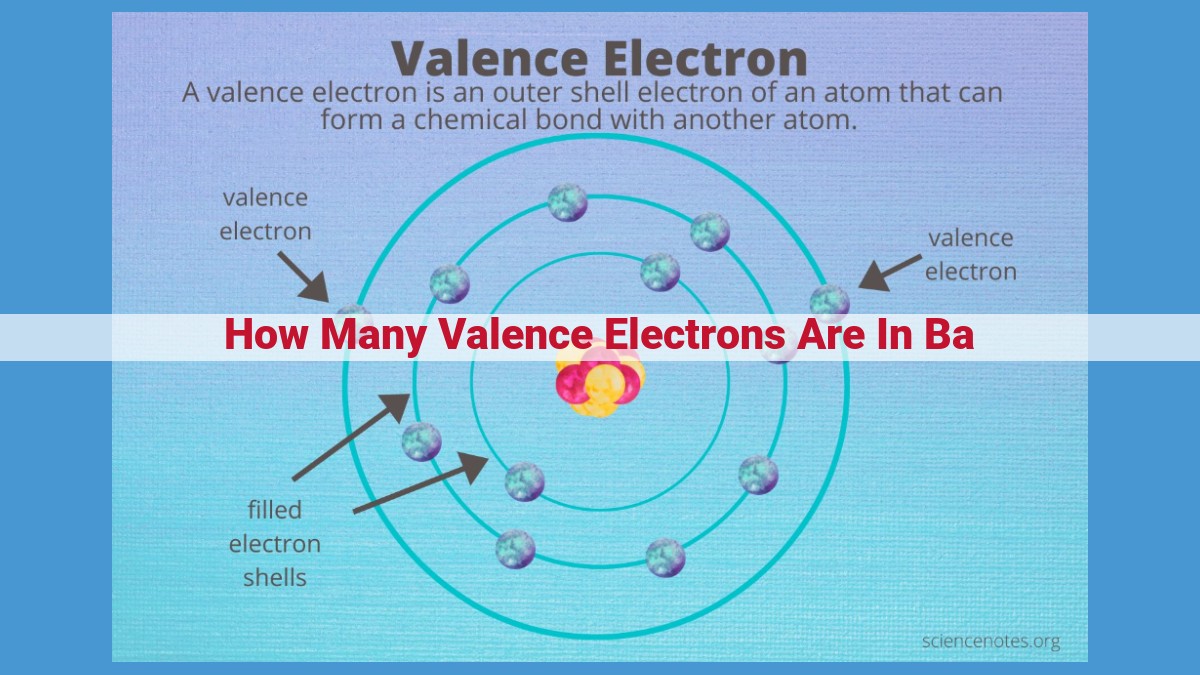Barium (Ba), an element found in Group 2 of the periodic table, possesses a total of two valence electrons. Valence electrons, located in the outermost energy level of an atom, play a pivotal role in chemical bonding and determine an element’s reactivity. Barium, with its two valence electrons, readily participates in chemical reactions to achieve a stable electron configuration. Understanding the concept of valence electrons and their significance for barium is crucial in comprehending its chemical behavior and properties.
- Definition and significance of valence electrons
- Their role in electron configuration and chemical bonding
What Are Valence Electrons?
In the vast realm of chemistry, electrons play a crucial role, and among them, valence electrons hold a special significance. They are the outermost electrons in an atom, residing in the highest occupied energy level. These electrons are the key players in determining an atom’s chemical properties and its behavior in forming bonds with other atoms.
Valence electrons are like the social butterflies of the atomic world. They are the ones that interact with other atoms to form chemical bonds, which are the glue that holds molecules together. The number of valence electrons an atom possesses determines its electron configuration, which is a blueprint of how its electrons are arranged around the nucleus. Electron configuration, in turn, greatly influences an atom’s chemical reactivity.
Significance of Valence Electrons
Valence electrons are not just mere bystanders in the atomic realm. They are the driving force behind the chemical reactions that shape our world. They determine:
- Atomic Bonding: Valence electrons are responsible for forming chemical bonds between atoms, allowing the creation of molecules and compounds.
- Chemical Properties: The number of valence electrons an atom has governs its chemical properties, such as its reactivity and its ability to form different types of bonds.
- Periodic Table Trends: The periodic table is organized based on the number of valence electrons, with elements in the same group (column) having the same number of valence electrons, resulting in similar chemical properties.
Navigating the Periodic Table: A Journey to Find Barium’s Secrets
Imagine yourself as a fearless explorer embarking on an adventure through the uncharted territory of the periodic table. Our mission: to unravel the secrets of a mysterious element named barium.
As we set foot into this scientific landscape, we stumble upon a crucial concept: atomic number. It’s like the address of each element on the periodic table, a unique number that tells us the number of protons in its nucleus.
Next, we encounter the groups (vertical columns) and periods (horizontal rows) that organize the elements. These are like neighborhoods and streets, with elements sharing similar chemical properties within the same group.
Our destination, barium, resides in Group 2, the column on the left-hand side of the periodic table. This group is a special one, known for its elements having a knack for losing two electrons.
And so, we finally pinpoint barium’s location on the periodic table: Period 6, Group 2. It’s like finding a hidden treasure, a crucial piece of information that will guide us in our quest for knowledge.
Determining Valence Electrons of Barium
In the realm of chemistry, valence electrons hold a pivotal role, governing the interactions of elements. Let’s embark on a quest to uncover the valence electrons of barium, a fascinating element that plays a crucial part in various chemical reactions.
Unveiling Valence Electrons
Valence electrons reside in the outermost energy level of an atom, determining its chemical behavior. They are the architects of chemical bonding, the forces that forge molecules and shape the world around us.
Navigating the Periodic Table
The periodic table serves as an invaluable guide in determining valence electrons. Each element is assigned an atomic number, representing the number of protons within its nucleus. This number governs the number of electrons in the atom, providing a crucial clue.
Barium’s Place in the Periodic Table
Barium, denoted by the symbol Ba, resides in Group 2 of the periodic table. This strategic location holds the key to its valence electron count.
Unveiling Barium’s Electron Configuration
To determine barium’s valence electrons, we delve into its electron configuration. Each element’s electron configuration describes the distribution of its electrons across energy levels. For barium, with an atomic number of 56, the electron configuration is:
1s² 2s² 2p⁶ 3s² 3p⁶ 3d¹⁰ 4s² 4p⁶ 4d¹⁰ 5s² 5p⁶ 6s²
Identifying Valence Electrons
The valence electrons are those in the outermost energy level, designated as 6s². This means that barium has two valence electrons.
In the world of chemistry, the number of valence electrons is a critical factor in determining an element’s reactivity and its ability to form chemical bonds. Barium’s two valence electrons make it a reactive metal, readily interacting with other elements to form compounds.
